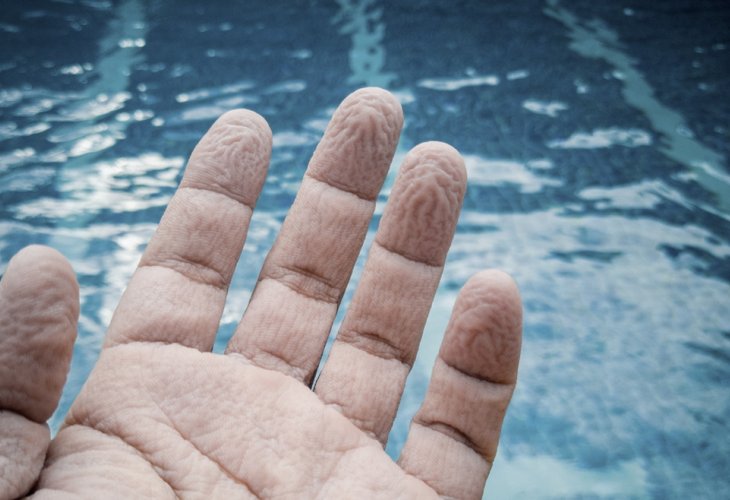Why Does Skin Wrinkle After Prolonged Water Exposure? 5 Points to Consider
Why do babies cry so much? How does a plant's nourishment system work? Does science contradict the sages about the snake's gestation? Where is the justice, and why do good people suffer?
 (Photo: shutterstock)
(Photo: shutterstock)"Wrinkled Fingers"
Have you ever noticed that after a long shower or swim, your fingers suddenly look wrinkly and "old"? Why does the skin wrinkle after exposure to water, and why only on the hands and feet?
Our skin is composed of three layers – the subcutaneous layer, the dermis, and the epidermis. The outermost layer of the epidermis (the visible part of the skin that allows us to feel touch) contains dead cells (keratinocytes), which are constantly shedding and being replaced.
One way to insulate the skin from the external environment, especially water, is by an oily secretion from the sebaceous glands (sebum) located in the hair follicles of the skin. This oily secretion is responsible for the phenomenon of "fingerprints" on different surfaces.
When we spend a long time in a watery environment, most of the sebum is washed away. The keratinocytes, no longer insulated from water, absorb it, causing the outer layer to swell and expand – while the layer underneath (containing living cells connected to connective tissue) remains unchanged.The inevitable result is that for the expanded tissue to "fit" the same surface area, it must wrinkle.
Why then does this process occur only on the skin of the hands and feet?
Because these areas specifically contain the thickest layer of dead keratin cells intended to protect them. This allows us to rub, injure, and damage the skin on the hands and feet without causing significant harm (which is a wonder in itself).
When the body "encounters" an increased amount of water, it "understands" that the environment might be slippery and dangerous. When we are wet, the "wrinkled" fingers allow us to grip objects or stabilize our bodies through holding. It turns out that like the grooves on car tires, wrinkles in the skin protect it in wet environments, preventing it from becoming slippery and dropping things or slipping and injuring oneself.
Miraculously, after leaving the water, a slow evaporation process takes place, and eventually the skin returns to its original state.
One cannot help but admire the supreme wisdom that created all these conditions!
But Why Cry?
When you're hungry, do you cry and scream? I assume not. When you're tired and want to sleep, do you cry and scream? I assume not. When you get a small bump on your leg, do you cry and scream? I assume not. When you're hot, do you cry and scream? I assume not.
Why do we not cry? Because there is no connection between crying and the problem, and crying does not contribute to solving it.
So why does a baby express all its desires and problems through one language it knows – crying?
Notice the kindness that Hashem has done for us: A baby is born and does not speak or communicate with its parents. How does it seek help? How does it tell its mother it's hungry, tired, or, heaven forbid, in pain? If it thinks to itself "I'm hungry," its parents won't know it's hungry. It can't prepare food for itself either... What did Hashem do? He set up a crying mechanism that operates automatically and greatly alarms the parents, informing them of the baby's distress at any given time.
 (Photo: shutterstock)
(Photo: shutterstock)
If we look closely, it's a perfect distress signal. Why? Because no parent can remain indifferent to the sound of a piercing cry, so they immediately approach the baby to "turn it off." And when they reach the baby, their heart cannot remain indifferent to seeing their crying infant, so they immediately act for the baby's welfare and provide what it needs.
If this were not a deliberate mechanism intended for a limited period, we would still have to cry and scream to indicate hunger today! But when the child begins to speak, the crying decreases. Why? Because now the child has another, more efficient mechanism to communicate with its parents, and the crying mechanism that served it until recently is no longer needed.
Imagine what would happen if there were no crying sound to indicate distress in the baby? How would we help it immediately when it becomes hungry? Without the crying mechanism, the baby might die of hunger! Who is it that "installed" this amazing protective mechanism in infants?
Transport System
Anyone who looks at leaves can see thin lines within them. What are they?
These are the veins, thin tubes that reach every corner of the leaf. Just as blood flows through human veins, nourishing all parts of the body, so sap (a fluid in plants rising from the roots) flows through the leaf's veins and nourishes it.
What is the significance of the leaf?
The leaf is the "factory" for the plant's food. Within the leaf occurs a very important process called photosynthesis, which produces food for the plant.
The parts of the leaf are: blade – the broad part of the leaf, petiole – the part connecting the leaf to the stem, and veins – tubes through which nutrients (sugars) flow from the leaf to the rest of the plant, and water flows from the roots to the leaves.
The splitting of veins into smaller branches that reach close to the cells of the leaf allows water to reach the cells directly without wasting water along the way.
Who is the "architect" responsible for planning and establishing an amazing transport system, similar to the blood transport system in our bodies – arteries and veins? A system crucial for one of the most important processes in the living world – photosynthesis, resulting in the oxygen we breathe!
7-Year Gestation!
There are skeptics whose sole purpose is to find one mistake in the Torah to show it is a human document and not binding. Yet we always discover anew that such criticism ultimately proves the Torah is from heaven!
For example:
In the tractate Bekhorot (8a), the gestation periods of animals are detailed: for instance, it says that the incubation period of a hen on eggs is 21 days, which remains true today. But there's a puzzling statement: "A snake for seven years." Meaning, the gestation of a snake is 7 years!
This data alarmed scientists since it contradicts reality. Most snakes lay eggs, but there are those that give live birth, with a gestation period of a few months! So how does the Talmud say 7 years? It's a mistake!
 (Photo: shutterstock)
(Photo: shutterstock)And why did this anger researchers who saw this Talmudic statement? Because the sages seemingly claimed to determine this from analyses of verses written in the Torah! They didn't understand how the sages announced based on verses, rather than deep, actual investigation, the gestation period of the snake.
To the researchers' amazement, it turned out that indeed the snake is an unusual creature regarding gestation. Thus, it's stated in "The Flora and Fauna of the Land of Israel" (Volume 5, page 30) on snakes: "Many reptilian species have a sperm storage in females, enabling fertilization after months, even years, from the time of mating, and in the female of one serpent species, six-year-old sperm was found!"
They discovered that the snake can – uniquely only to the snake – give birth seven years post-mating, because the female snake can store sperm in her body for many years after mating, and after this time, she can fertilize herself and conceive!
Thus, it appears the sages referred to the maximum time the female can delay childbirth, as Rashi writes there: "How long gestation remains inside." That is, gestation can last up to 7 years, and the intention is not that pregnancy lasts 7 years.
How did the sages know this? Where did they acquire this marvelous zoological knowledge?After all, they did not have the sophisticated scientific tools available today!
We Don’t Understand Heavenly Calculations
A person endured a severe test, and afterwards was injured in a car accident. Is this the reward for observing the Torah? How can it be that the righteous suffer while the wicked prosper?
Once Elijah the Prophet, as the story goes, embarked on a journey with Rabbi Joshua ben Levi, who longed to learn his ways and understand his wisdom. Elijah set only one condition: not to question his actions.
On their first visit, they arrived at the home of poor people who hosted them with great warmth – offering them food, drink, comfortable lodging – all with a pleasant demeanor, despite being poor and having only a milk-yielding cow as their source of livelihood. In the morning, after they awoke, to Rabbi Joshua's astonishment, Elijah prayed for the cow to die. The cow died immediately. Rabbi Joshua did not understand why instead of reward for their beautiful hospitality, the poor lost their only livelihood, but – faithful to his promise – he said nothing.
On the second day, they stayed with a wealthy man who didn’t exactly "roll out the red carpet" for them, but rather treated them with much disdain, offering neither food nor drink. The guests noticed that this wealthy man had a wall that had collapsed, and he now had to rebuild it. In the morning, Elijah prayed for the wall to be rebuilt by itself – and so it was. Again, Rabbi Joshua wondered at the "reward" given to this arrogant wealthy man, despite his unworthiness, but he remembered his promise not to ask anything.
Only at the end of the journey, filled with wonderment, did he ask to understand the meaning of these strange actions. Elijah replied: "Know that the man whose cow I killed – that day his wife was destined to die, and I prayed to Hashem that his cow be his wife's redemption. And the wealthy man whose wall I rebuilt – had I let him build it, he would have uncovered its foundation and found a treasure of gold and silver – and so I built it for him."...
Friends, imagine the moment: that poor man wakes up in the morning to find his cow – his only source of income – dead! How would he react? Surely he would lament his fate, possibly complaining to Hashem: "There is no justice! Only yesterday did I fulfill the commandment of hospitality – and this is my reward?!"
But if he knew that thanks to their good deeds, Hashem decided that the cow would be his wife's redemption and she would die in its place, how would he react then? Without a doubt, he would be dancing with joy and endlessly thanking Hashem for the kindness he was shown!
All of us encounter damages, problems, and difficulties occasionally. This story teaches us that not everything we see is truly to our detriment. Not only that, but it also turns out that the mitzvot we perform "exchange" our punishment for a lighter punishment, and we are unaware of it! The ways of Hashem are hidden, and not everything that appears good is truly good, nor is everything that seems bad, truly bad.
Everything is for the good! We see the world superficially, but Hashem sees it in-depth in that same point; He sees the end of the sequence. So, if damage or a certain difficulty occurs to you, do not complain or blame everyone around. Stop and think ahead: it could be that the damage you experienced today is the salvation that Hashem is sending you for tomorrow...

